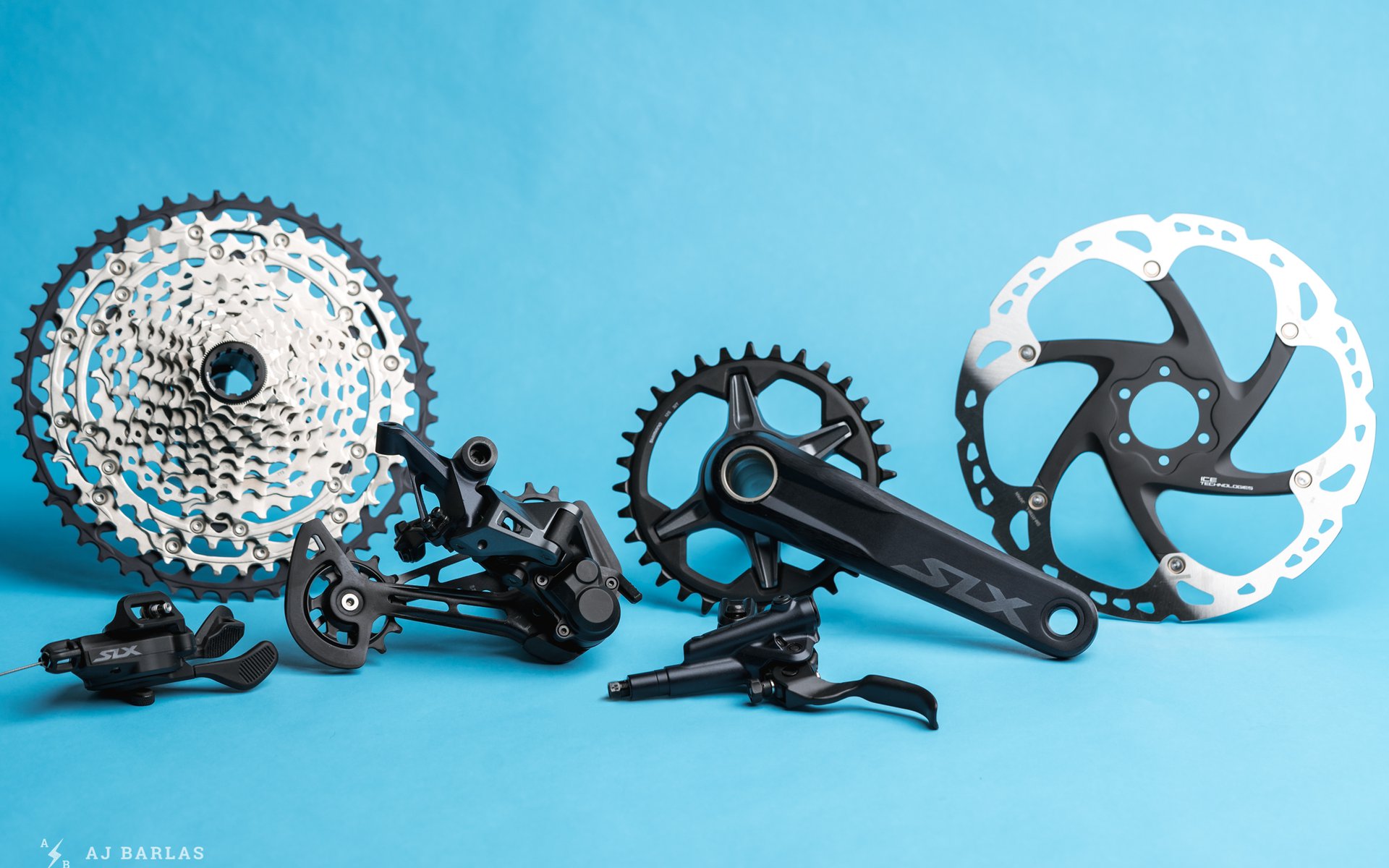
SLX GROUP REVIEW - PART 1
Shimano SLX Drivetrain Review
XTR is Shimano's top of the line and XT follows closely behind and there was a time when the performance drop off below the XT level was severe, but it appears that's changing. Shimano has trickled down many of the features of the top two groups to the lower cost SLX group and much of the quality and precision of the top two groups are present here, with one modest upgrade. We’ll get into that below but after spending considerable time on a Shimano XT drivetrain and six months on SLX, I've been left impressed.
I’ve spent tallied over 700km of off-road use on SLX in everything from winter slop to dry, blown-out moon dust. I've had one derailleur mishap thanks to a root, bending the outer plate of the cage by the lower jockey-wheel. Thanks to the metal construction of the derailleur, it was quickly fixed and hasn't been a problem since. Line choice and trail obstacles are hardly the derailleur's fault.
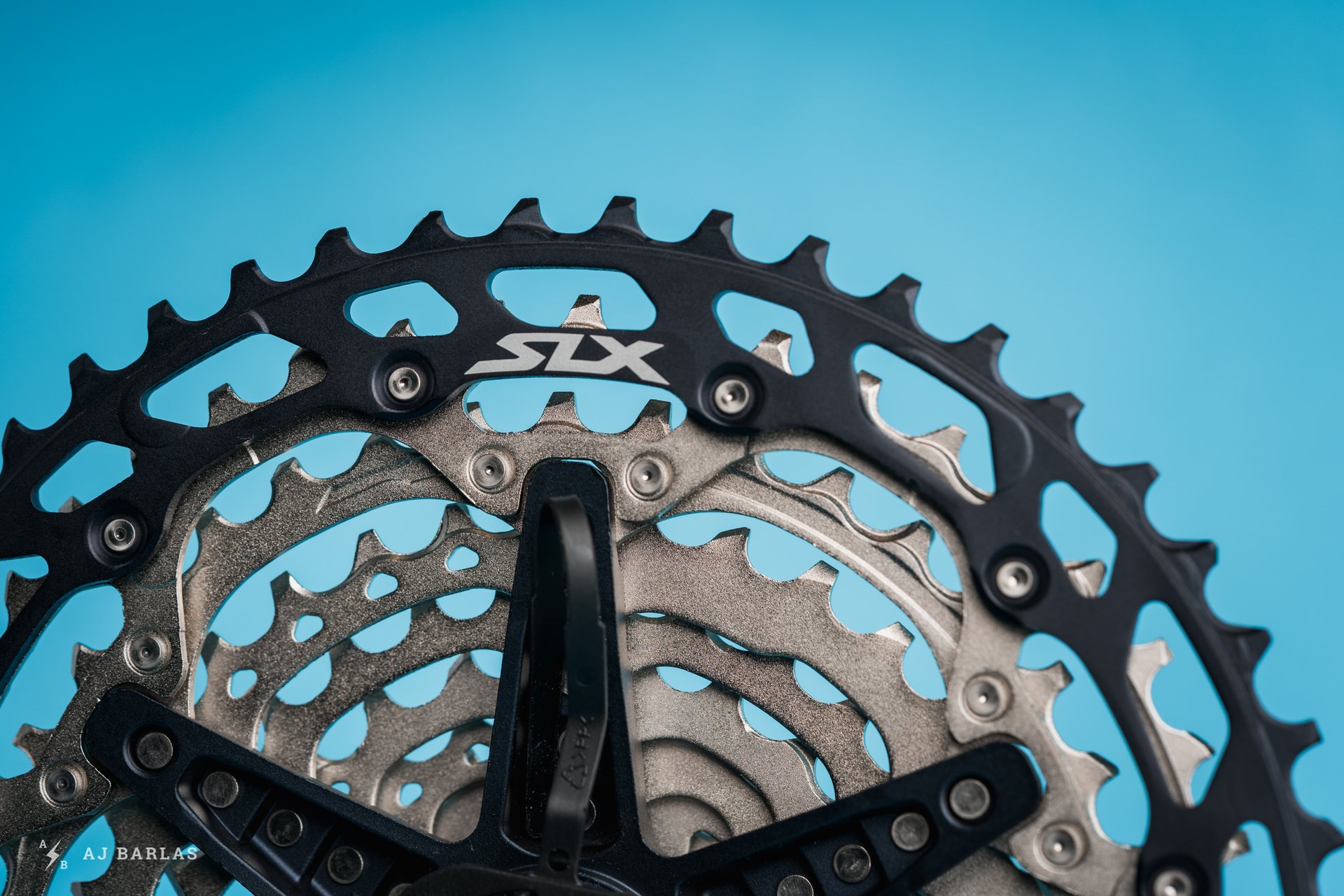
The previously overlooked little brother in the Shimano lineup now demands our attention.
Shimano SLX (M7100) Drivetrain
Before the 12-speed SLX group arrived I’d been happily riding the SRAM equivalent; GX Eagle. SRAM drivetrains once again found a home on my bikes when the 12-speed option was released and like many, I've been quite happy with the performance. Without beating around the bush, the 12-speed Shimano SLX drivetrain has features that I prefer over GX. The best for you will depend on how you weigh the importance of performance, budget, and weight.
Features:
- Hyperglide+
- 10–51T Cassette w/ alloy easiest ring
- 510% range w/ 10-12-14-16-18-21-24-28-33-39-45-51
- 10–45T Cassette also available
- Shadow RD+ rear derailleur
- Two-way release shifter
- Hollowtech II cranks w/ single ring setup
- 30, 32 (tested), and 34T size options
- Steel teeth mated to an alloy 'spider'
- Three crank lengths options: 165mm (tested), 170mm and 175mm
- Weight: 1,589g (inc. gear cable, 73mm threaded BB)
- MSRP: 409.93 USD
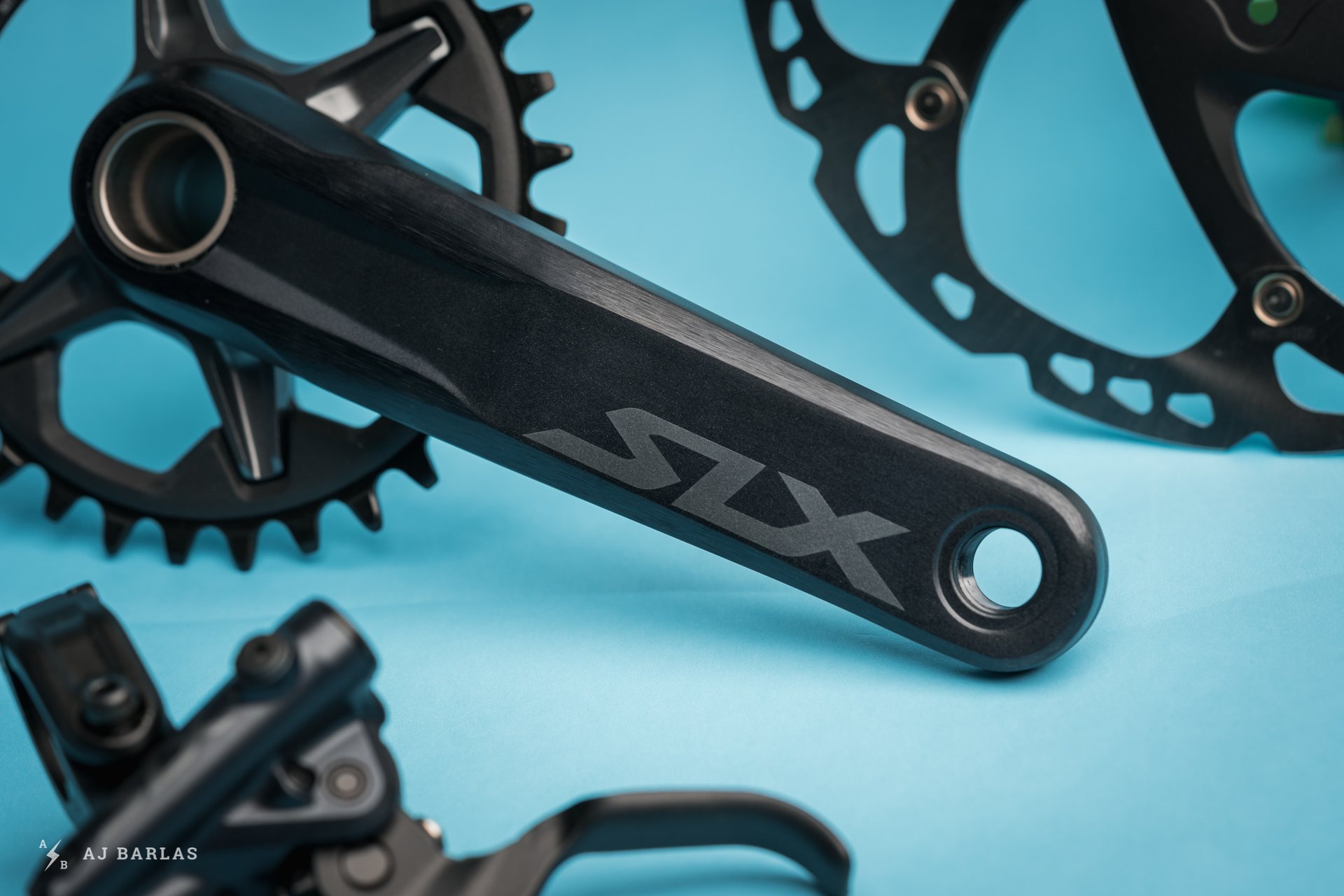
SLX cranks are available in 175, 170 and the 165mm lengths tested here. They're constructed of alloy using Shimano's Hollowtech II technology, which has proven itself over the years.
Getting Set Up
12-speed SLX set-up and installation doesn't differ greatly from previous Shimano drivetrains and when stacked against 12-speed XT, it’s essentially identical. There are some subtle differences between the two tiers but they’re minimal. Looking at the cranks, there's a slight visual difference to the finish and the SLX weighs a few grams more than an equivalent XT setup (with similar crank length and chainring size). But we’re talking about a claimed ~10 grams. The SLX cranks tested were in the 165mm length and with a 32T chainring they tipped the scales at 625g. Their short 165mm length is worth noting too; I’ve previously had a difficult time finding this length with a 73mm BB, especially at lower price points, but it's now available in both XT and SLX.
I’ve always enjoyed the simplicity of the Shimano crank setup and it remains the same with the latest SLX. The cranks easily bolt together from the non-drive side and with the now common double pinch bolt securing everything in place, I’ve had no issues. There's no need for self-extraction or crank-pullers with everything sliding together easily with a few bolts. As with the XT drivetrain, the new chainring features coated steel teeth mated to an alloy spider that’s mounted directly to the cranks.
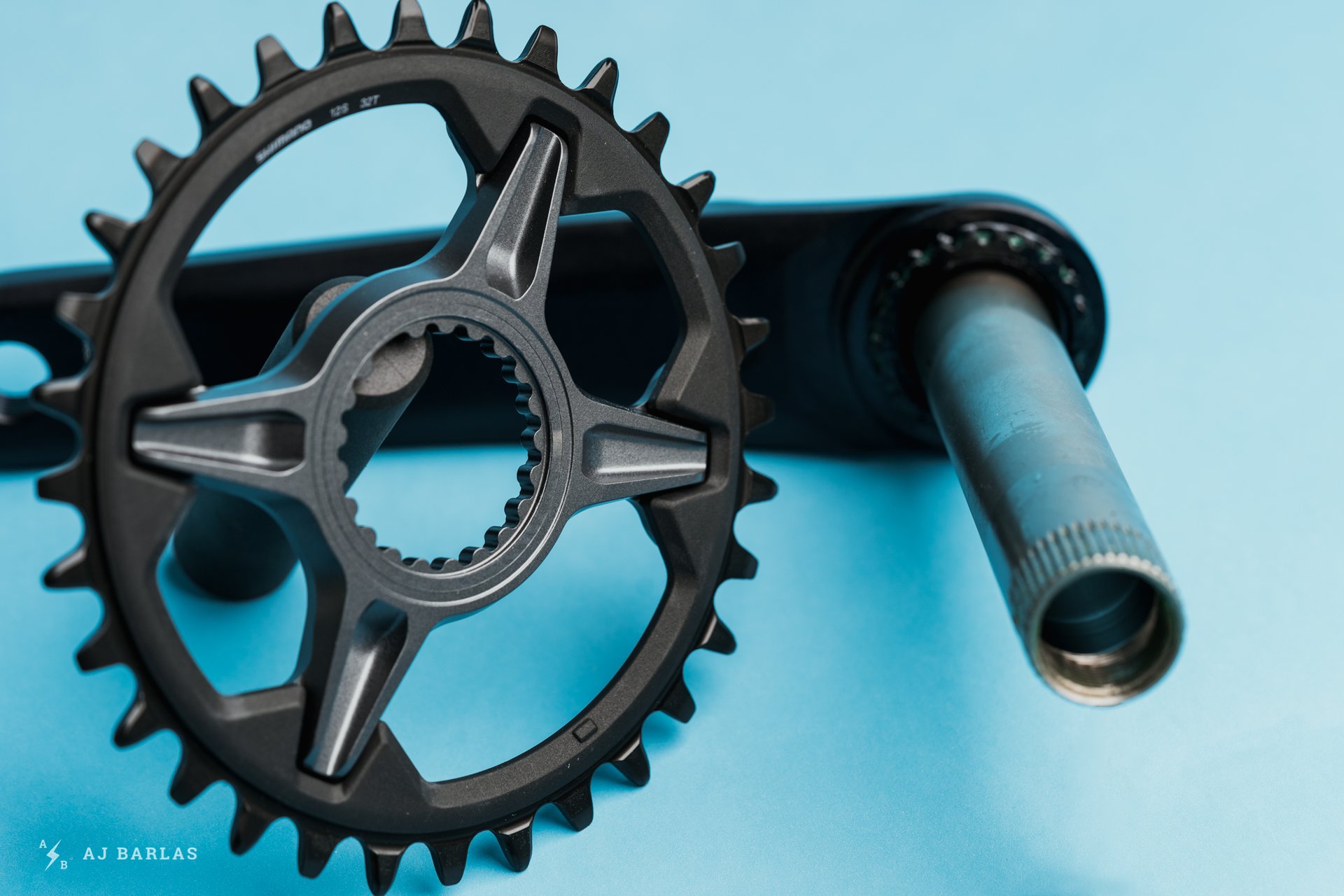
The chainring is a combination of steel teeth mated to an alloy spider that mounts directly to the crank.
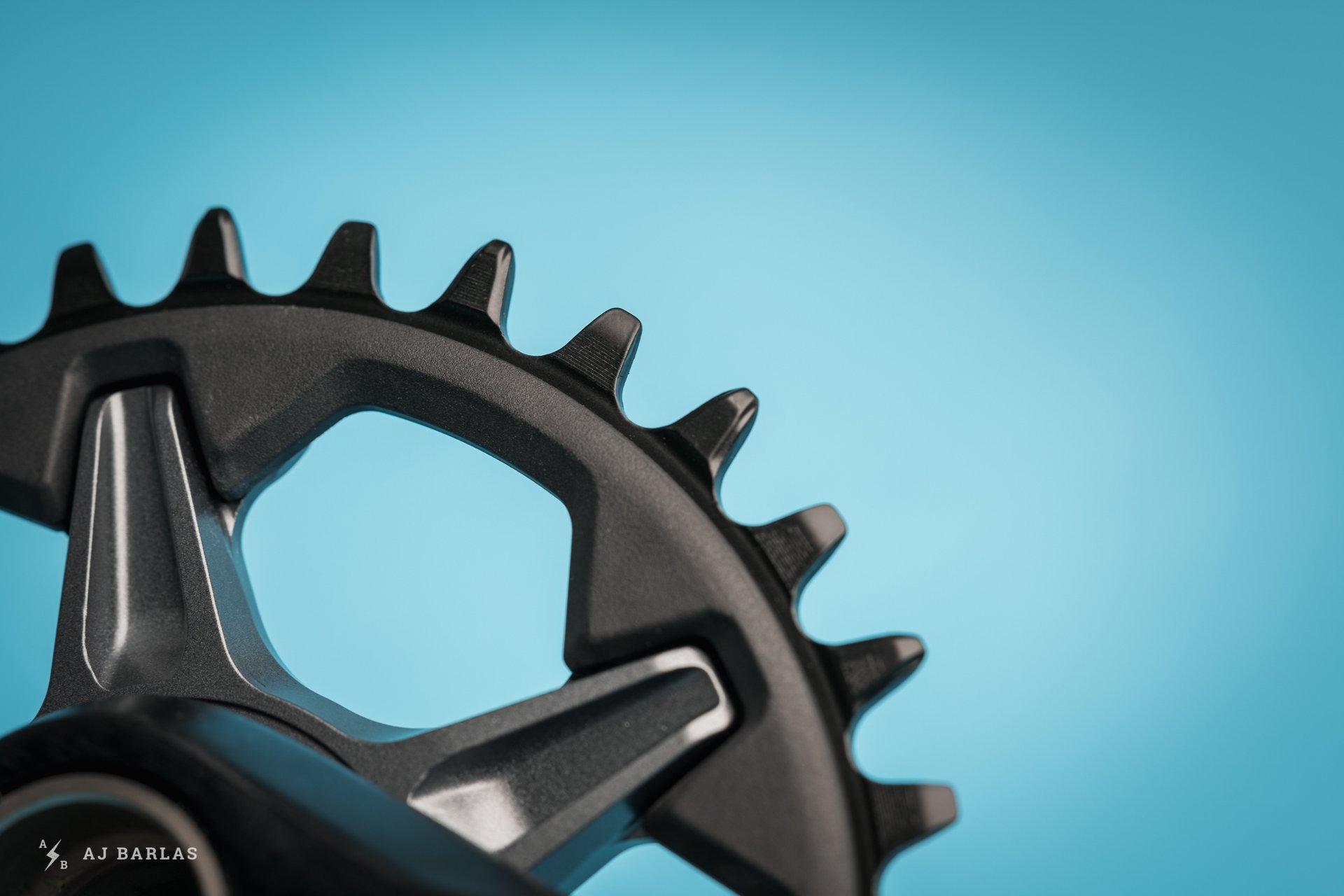
The black coating wore off reasonably fast but since then, there's been little discernible wear.
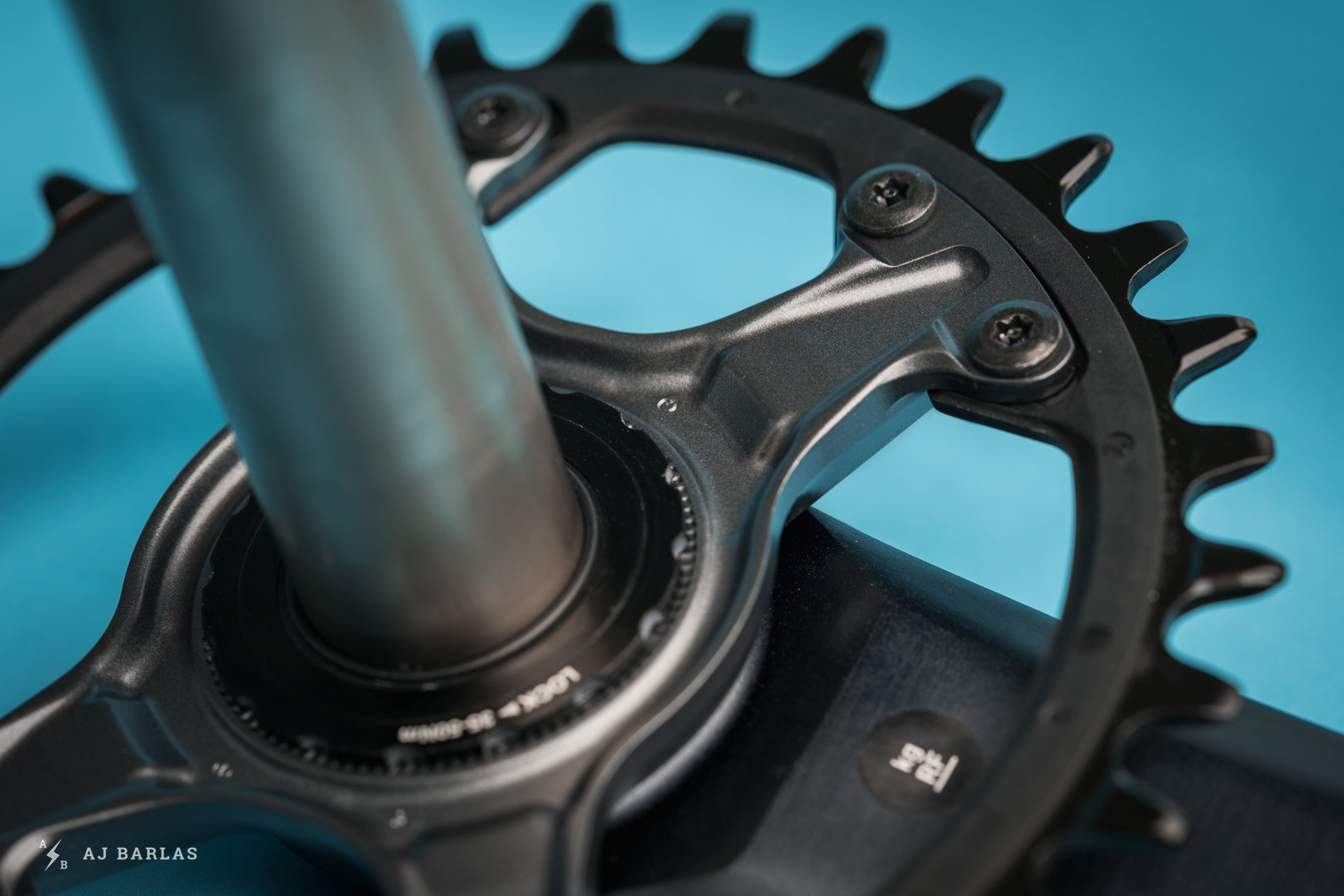
The entire alloy and steel chainring is replaced as one part when the time comes.
At the rear of the bike, the toughest thing was waiting for a Microspline driver for the Newmen A.30 wheels. More brands have Microspline drivers available now and even smaller outfits like White Industries have one for their XMR+ hub. The SLX cassette has more pieces than the SRAM GX, which is a pinned one-piece design, and that made getting it on trickier. Shimano includes a plastic carrier that simplifies things when mounting but it’s still relatively fiddly and less than ideal. Whenever removing the cassette from the driver I’ve attempted to slide it back onto the plastic carrier but it’s proven quite cumbersome.
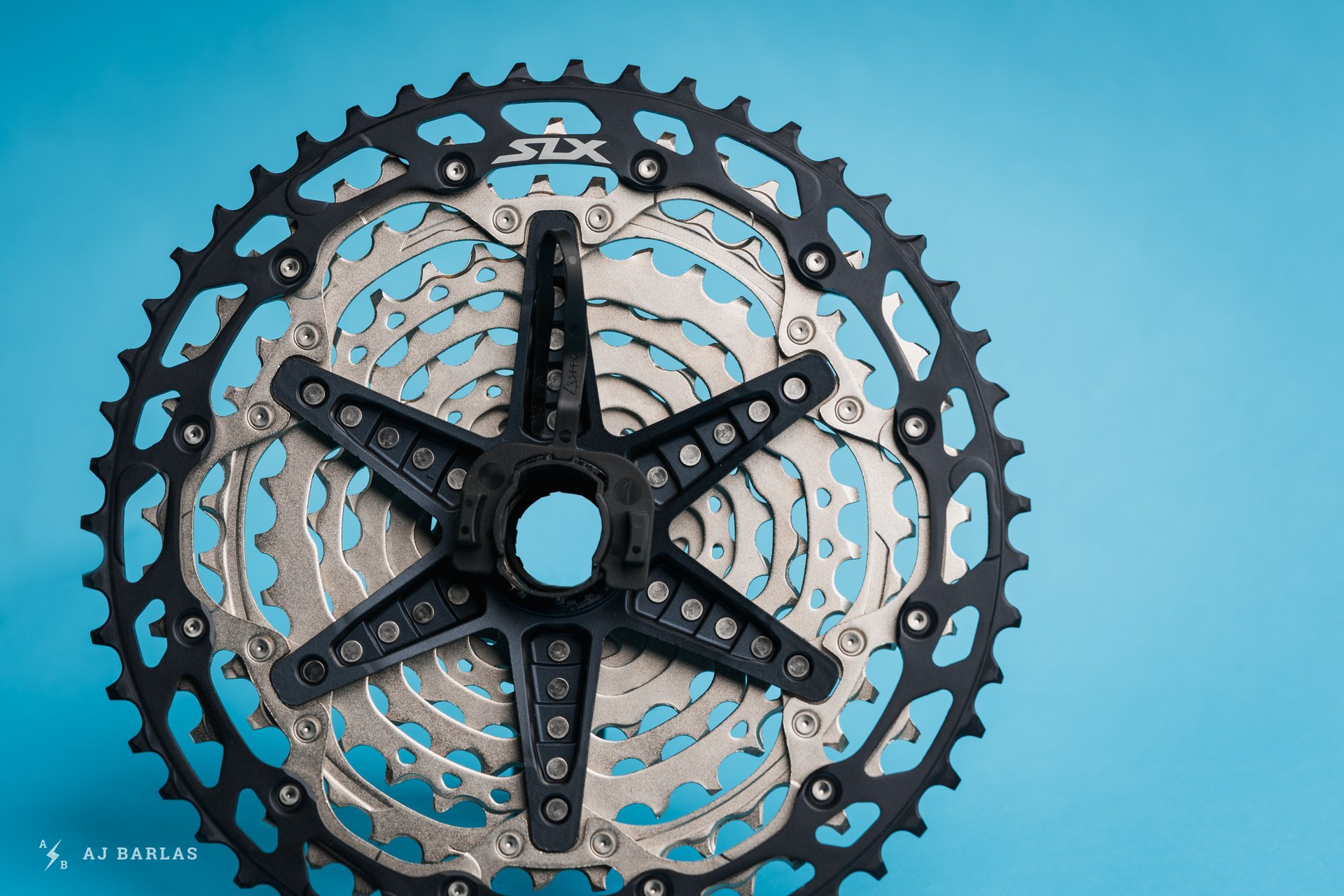
The SLX cassette's construction is the same as XT and XTR. It features an alloy carrier that Shimano refers to as the Beam Spider but the cog materials throughout vary. Also pictured is the plastic carrier included with the cassette.
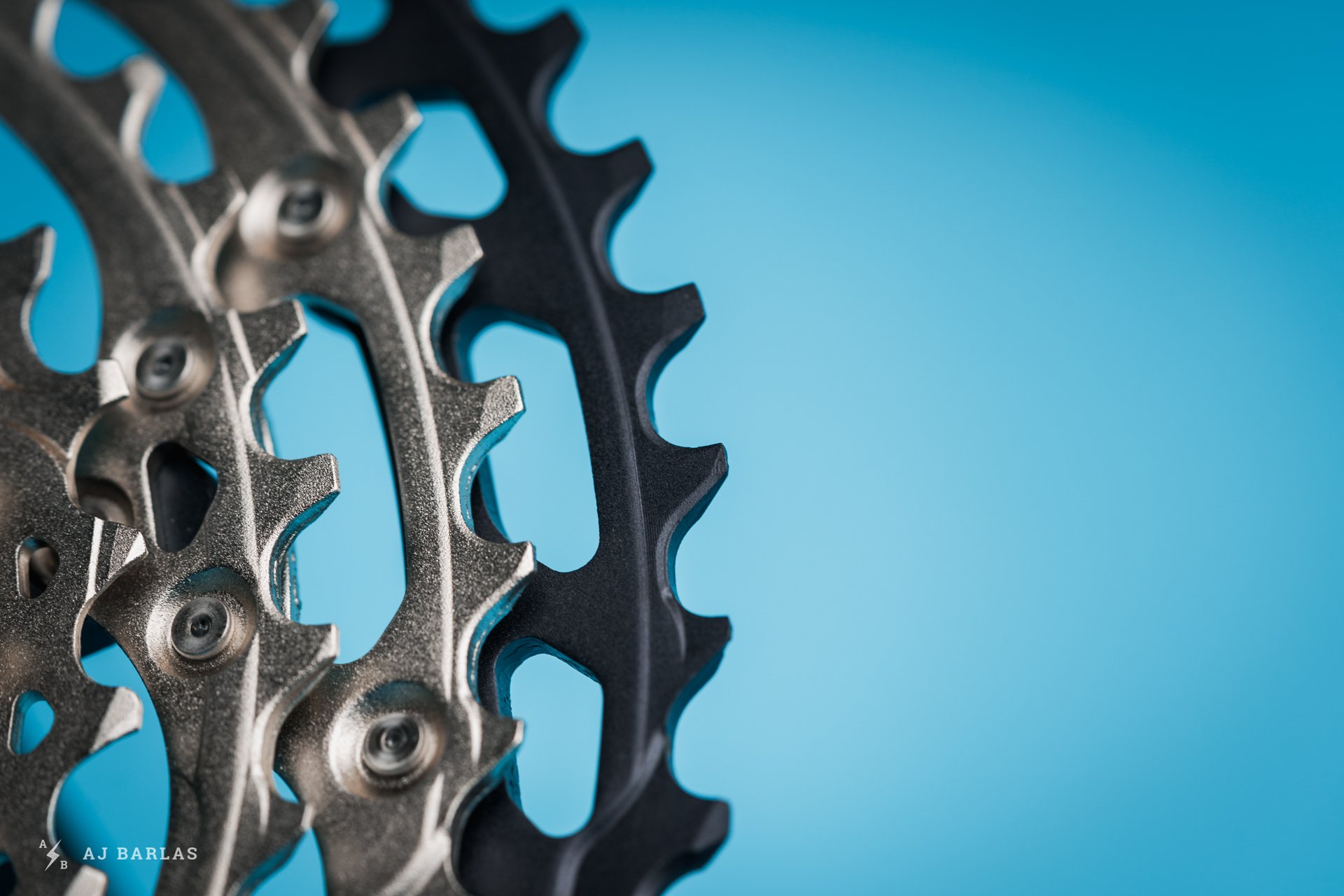
Only the 51T cog on the SLX cassette is alloy.
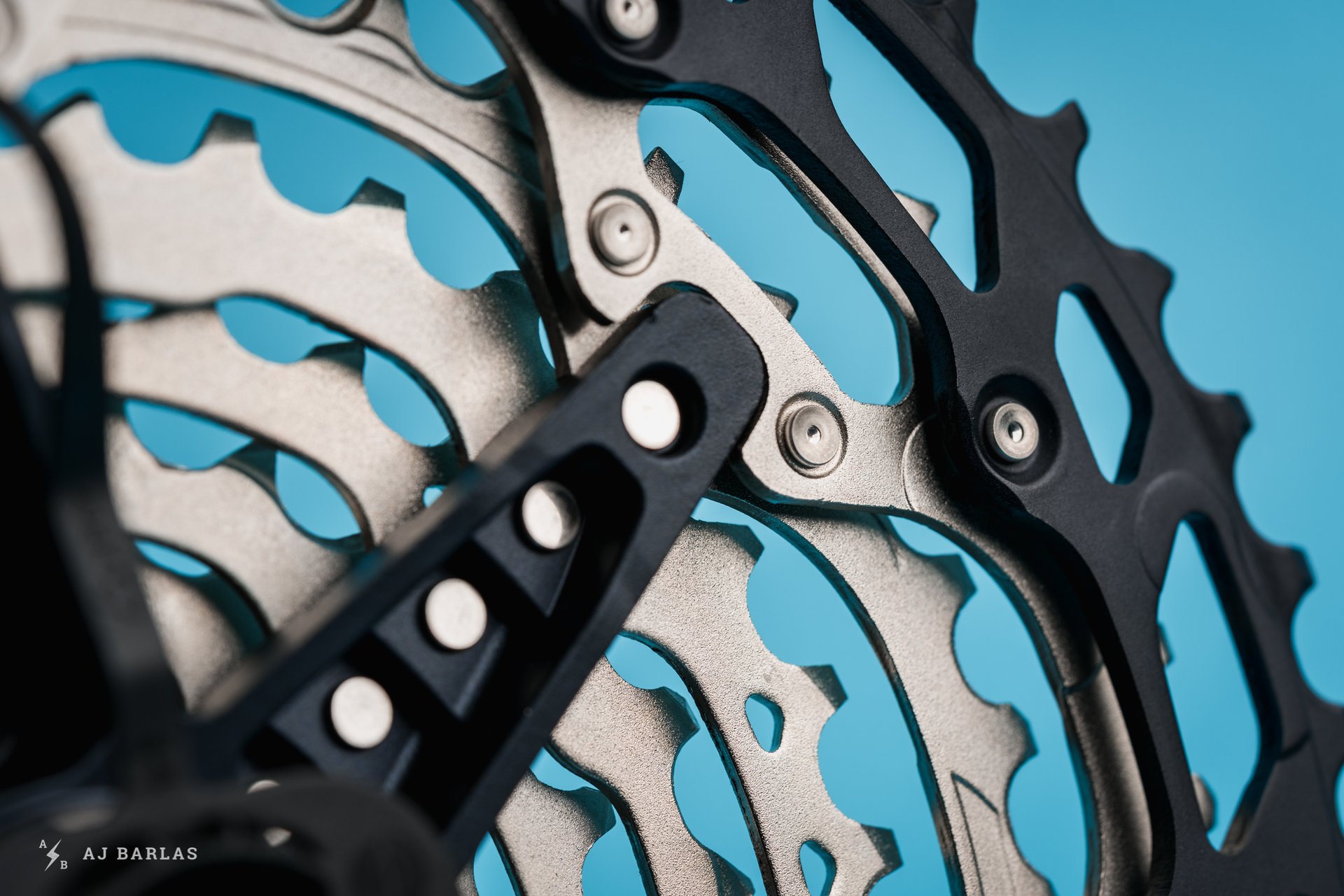
The "Beam Spider" and how the first and second cogs integrate with it to complete the cassette.
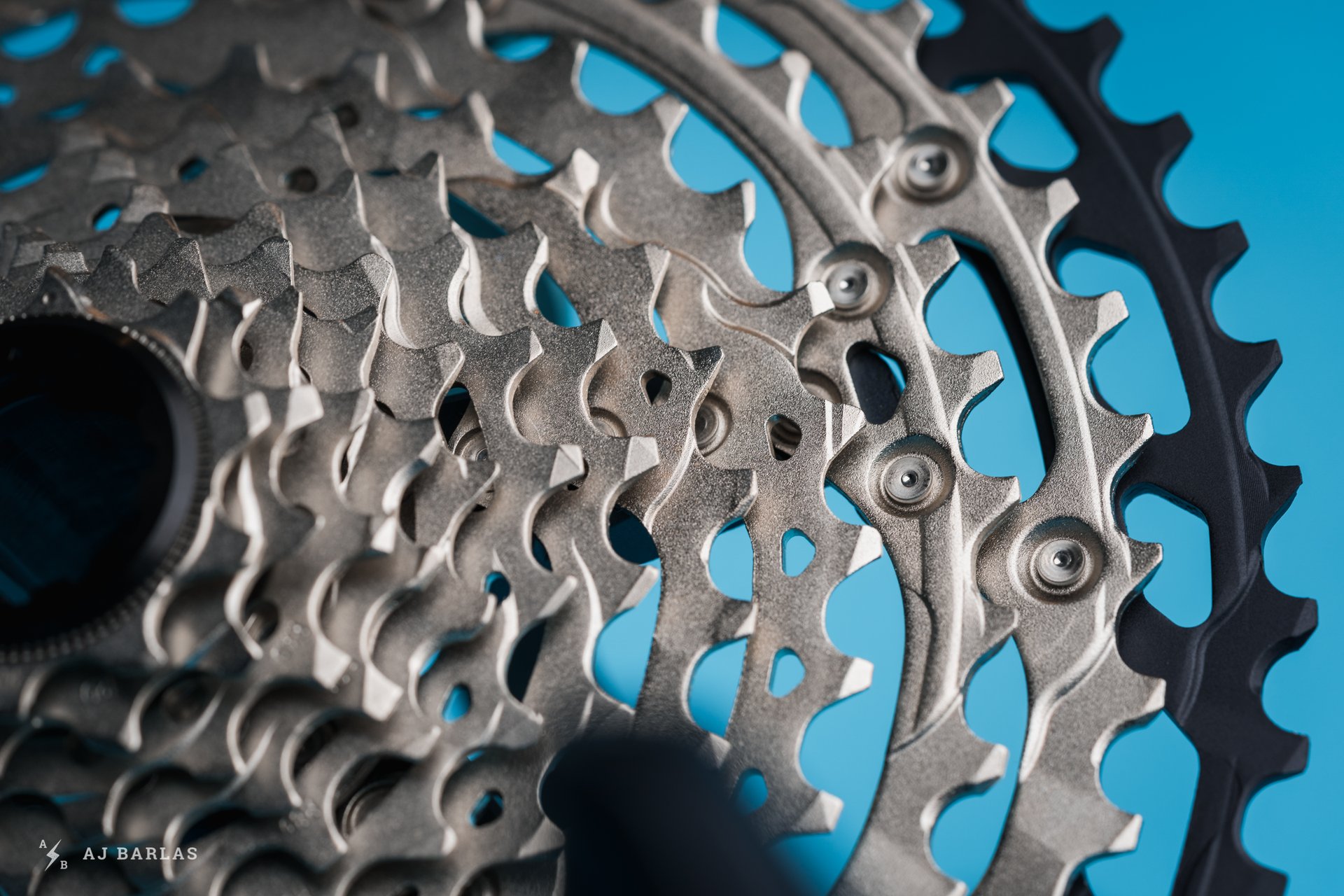
The 12-speed SLX, XT and XTR cassettes feature Shimano's new Hyperglide+. This combined with the longer inner plates on the chain provides excellent shifting
The derailleur and chain setup were problem-free, with the assistance of the b-tension marking at the back of the cage making it even easier. I used my old chain length to set the SLX chain but for those building a new full suspension bike, Shimano recommends a full wrap of the drivetrain plus 5–6 links before the quick-link. Admittedly, I initially rode the bike with the b-tension set by feel before stumbling upon the marker on the derailleur. My initial setup was off and while it still performed great, I noticed a slight improvement once set using the b-tension reference marker.
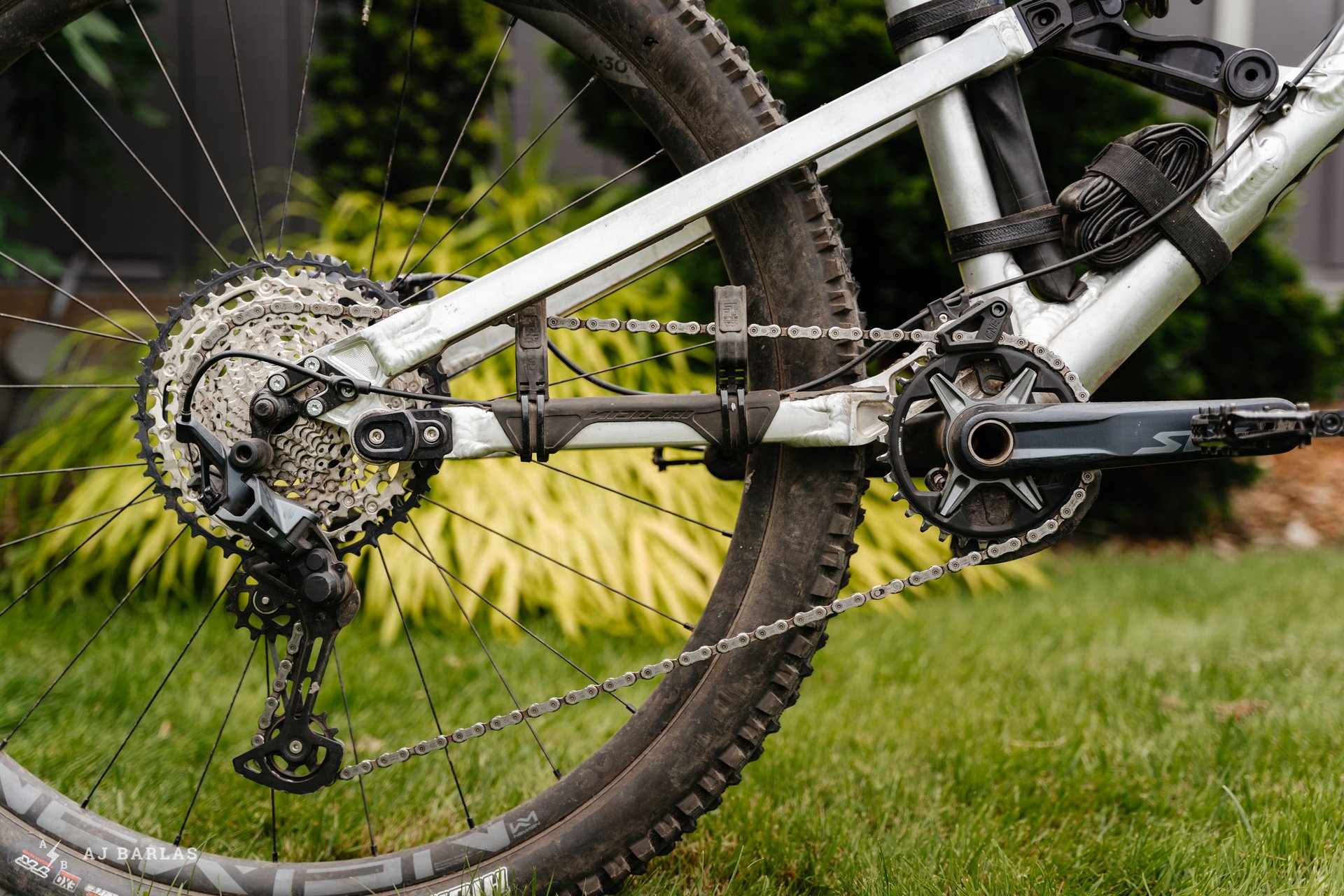
After 700km and some good knocks, the SLX 12-speed drivetrain hasn't skipped a beat.
Grinding Gears (At Least Trying To)
Despite wet, grimy conditions, the SLX drivetrain was quiet and shifted like something far more expensive. Compared to the GX drivetrain I’d come off, the shifts felt tighter and more precise. It remains that way to this day. Shifting down the cassette into harder gears, I found little difference between the two drivetrains but when moving to easier gears the more precise shifts of the SLX were obvious. It often felt as though the worse I shifted – under load thanks to poor timing or having to bail from a bad gear selection – the better it performed. I’ve been woefully unsuccessful in getting the SLX gears to grind or skip.
I’ve discovered that I prefer the gear ratios in the Shimano cassette. Shimano's four largest cogs are 33t, 39, 45 and 51, while SRAM's are 32t, 36, 42 and 50 (or 52 for new cassettes). It doesn’t sound like much, but in the four lowest gears I find things more comfortable with the Shimano gearing thanks to the more gradual steps. I can happily sit in each gear where I often find myself between gears with SRAM. Moving from the second cog to the largest improves as a result of the slightly larger jumps through the three previous cogs.
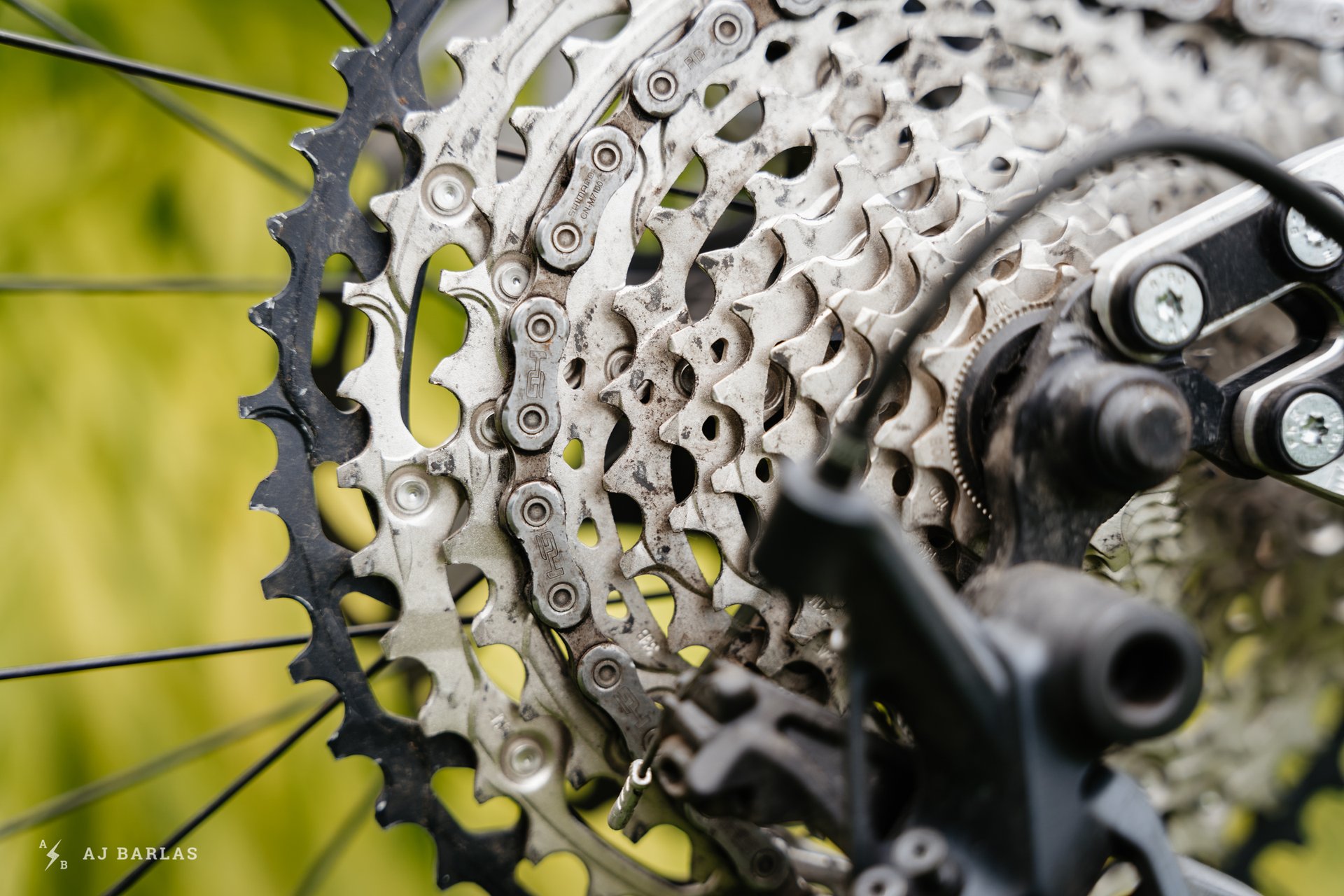
From gear four (pictured) up to the easiest I found the Shimano cassette to provide a more comfortable ratio on the trails.
The SLX cassette jumps 6 teeth from the 45 to the 51 where the SRAM jumps 8 moving from 42 to 50 (and now 10 with SRAM's new 10–52T). The larger jump has always felt like too much to me, causing a more pronounced change in cadence and momentum. This is exaggerated by the tighter jumps leading up to it. Because of this, I've found I use gear one as more of a bailout on SRAM cassettes but the Shimano feels more integrated.
SLX feels so similar to XT, I honestly couldn’t tell the difference. Or rather I couldn't once I switched out the SLX shifter for an XT. There’s no Multi-Release with the SLX and that for me was a bummer. Anyone who's spent time on Shimano in recent years should be familiar with the ability to shift two gears in one deep press of the release lever. When Shimano first presented the Multi-Release technology I remember scoffing that it was just a marketing ploy but in practice, I’ve grown very fond of it. So much that it's the feature I miss most when riding a SRAM drivetrain.
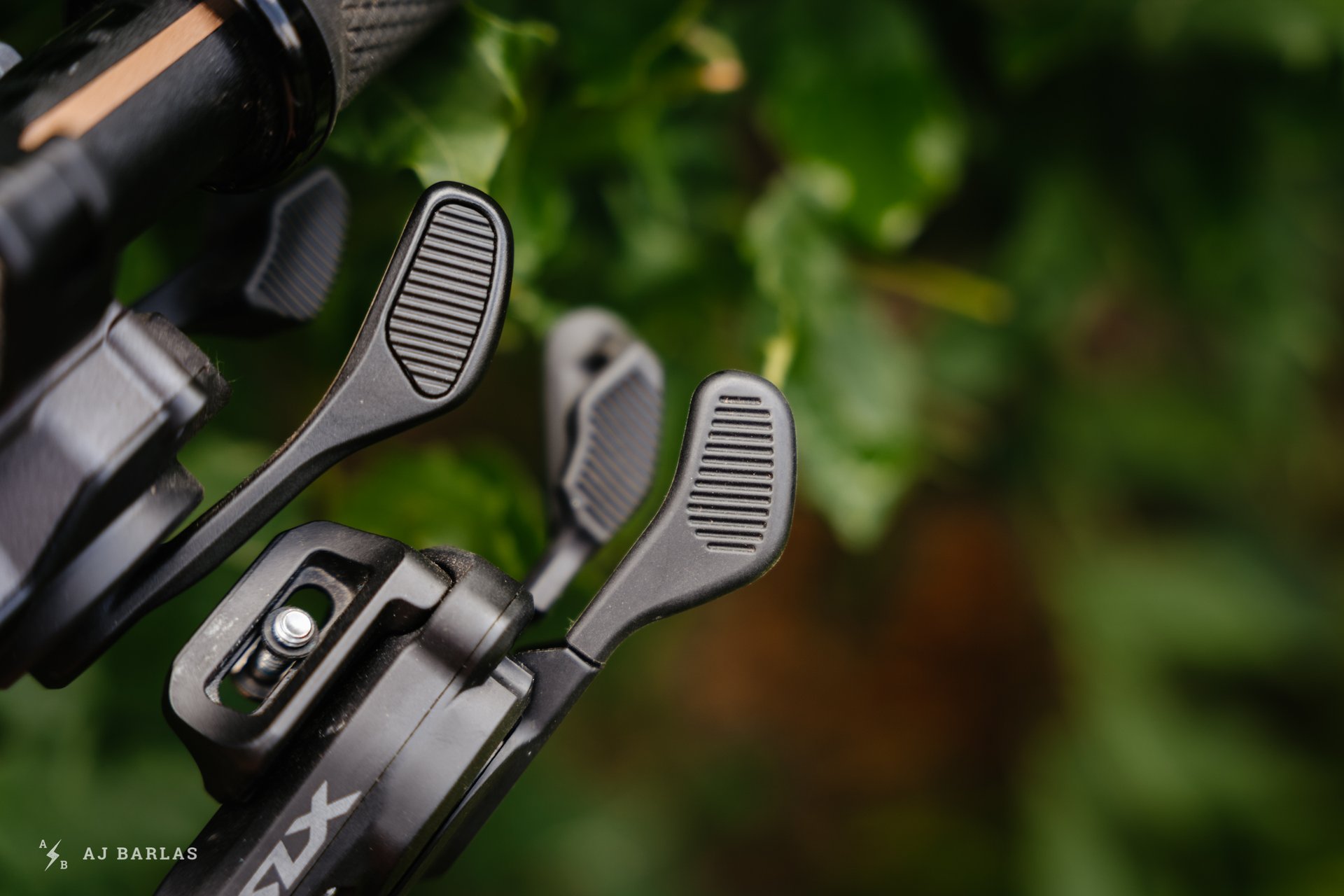
Aside from the internal differences – no Multi-Release or Instant Release – construction of the SLX shifter differs externally. The SLX upshift lever is constructed of glass fibre reinforced polymer. The XT lever is made of alloy and features a textured rubber surface for more grip.
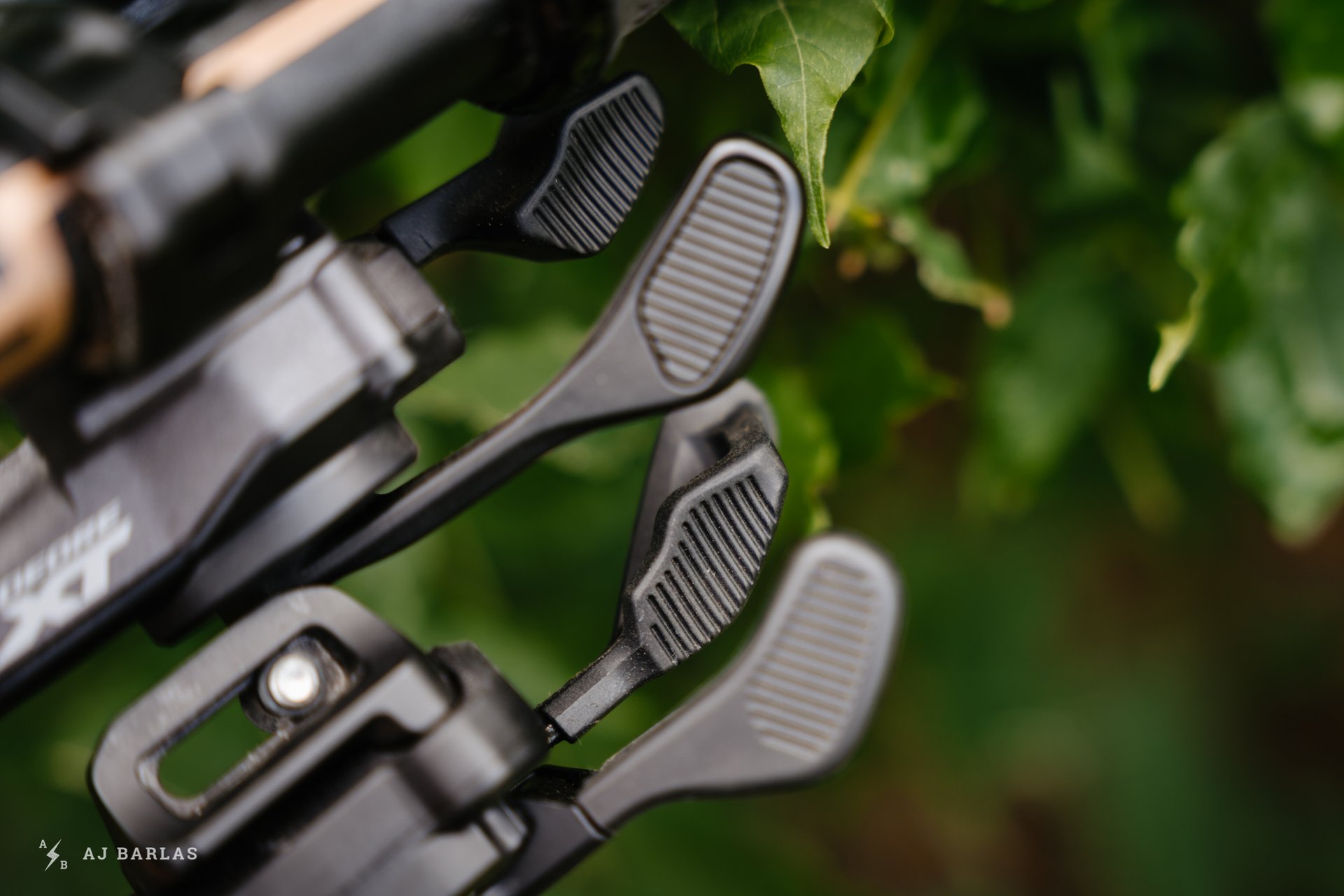
The shape of the release (harder gear) shifter paddle also differs a bit and the SLX shifter uses bushing in two places where the XT utilizes bearings.
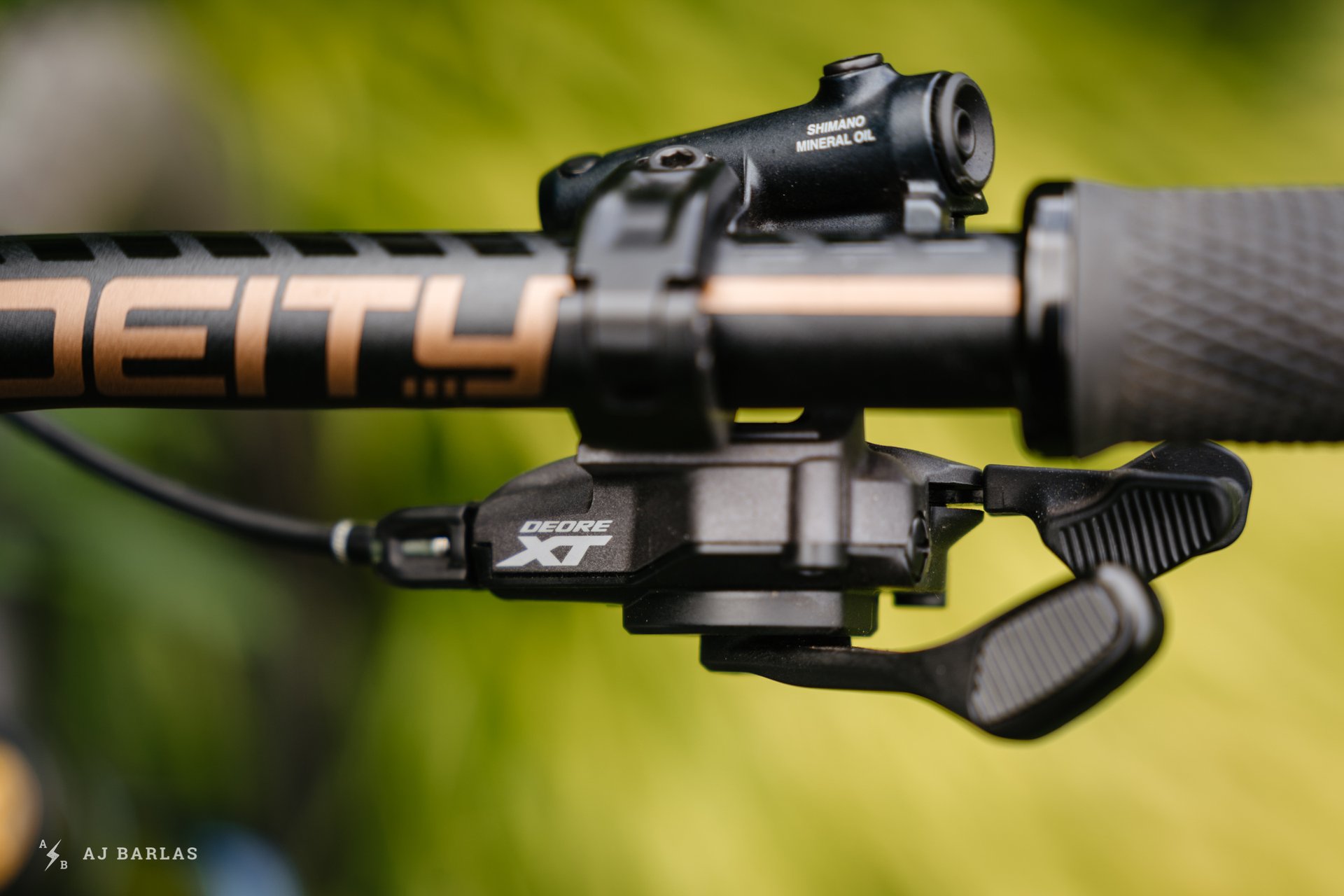
The XT shifter is a worthwhile upgrade with the SLX drivetrain. It provides the shifting performance of the higher priced drivetrains without the associated cost.
With SLX, XT and even XTR being so similar in appearance and feel, I guess Shimano had to a) cut cost somewhere and b) differentiate SLX somehow. I was bummed but that’s not where it ended. While the shifts on the SLX drivetrain feel tight and accurate through the pedals, the SLX lever lacks the feel and immediacy of XT. Shimano hasn't included Instant Release in the 12-speed SLX shifter and the result of the two-stage shift is a sloppy, less tactile feel. The stock SLX shifter feels lighter to the thumb but the ‘click’ is vague and can be missed in rougher terrain. With the XT shifter, gear changes were faster and tighter again, making the difference between the higher-priced XT disappear on the trail. This combined with the ability to shift to two higher gears at once makes the upgrade worth the additional ~30 CAD / ~21 USD.
Another subtle difference between the SLX and XT drivetrains is visible in the cassette. SLX includes one alloy cog – the largest cog – where XT includes two. The SLX weighs about 60 grams more but one less alloy cog should increase durability, with only the lowest gear using the faster-wearing metal. And while the closer ratios make the largest cog feel more integrated, I only find myself using it on hell climbs, or when I’m shattered. I could probably get away with the 10–45T cassette or as Andrew Major has suggested before, fewer gears. But of the Shimano 12-speed cassettes, there’s no question which one I'd run. Even if I could be convinced to fork out the extra money for XT I would still opt for the SLX cassette because only one cog is made of less durable aluminum.
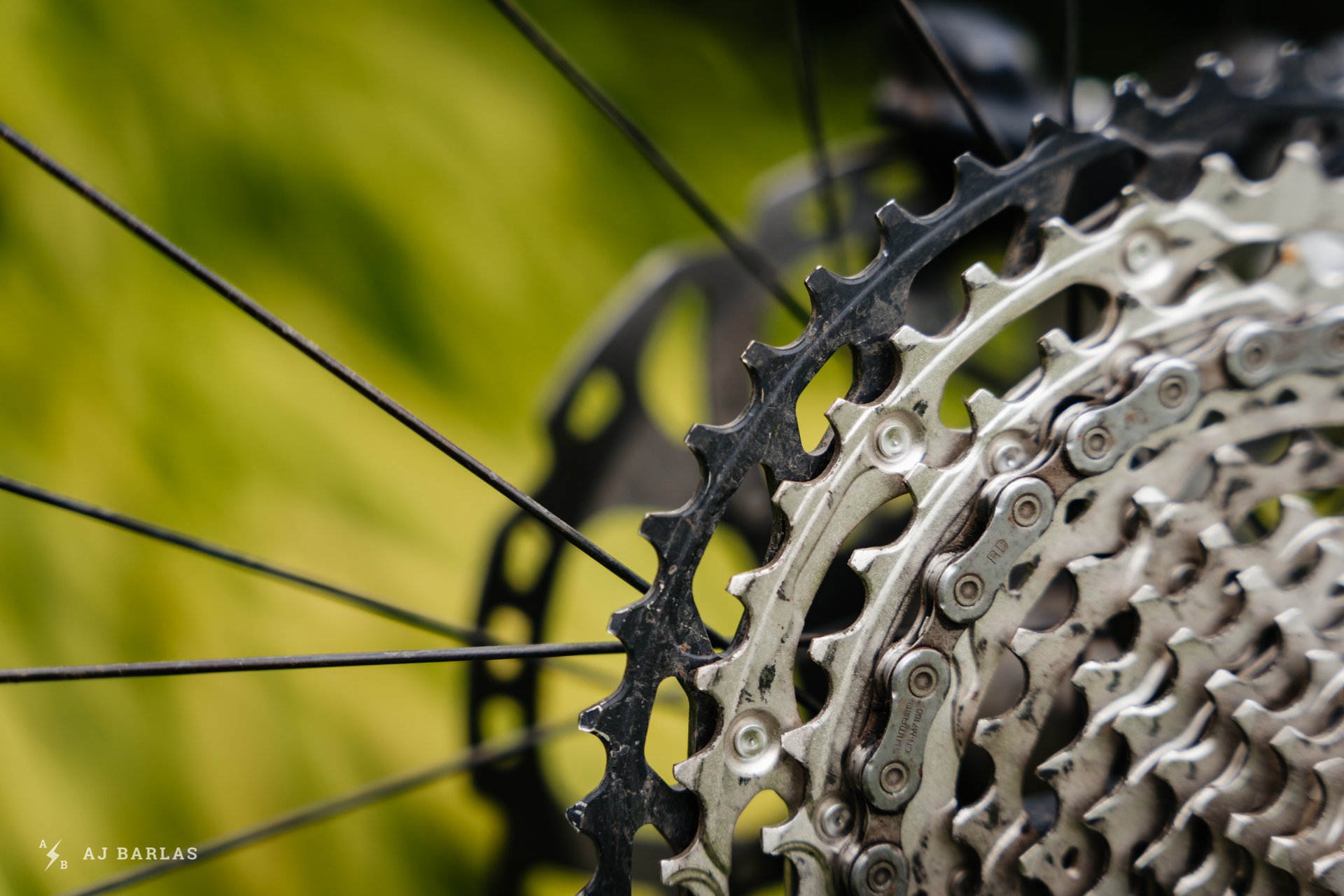
The SLX cassette has only one aluminum cog, compared to two on the XT. I more regularly use the second gear and not having the softer metal here will see me get more life out of it before it needs replacing.
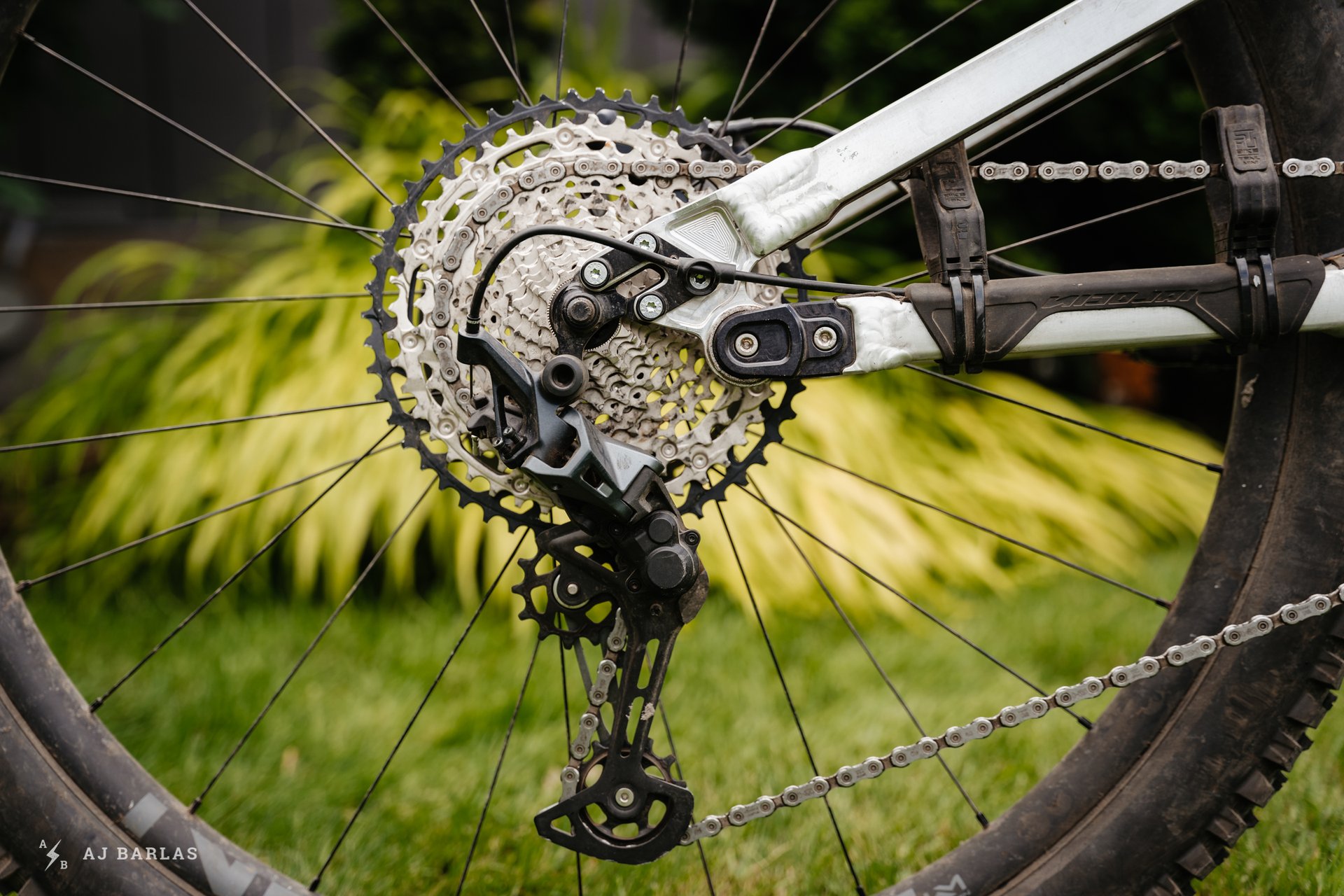
The SLX cassette carries more heft than its more expensive siblings but I don't believe the cost associated with the weight savings is worthwhile. It's also heavier than the GX cassette. The clutch on this SLX derailleur has had no issues and it is serviceable.
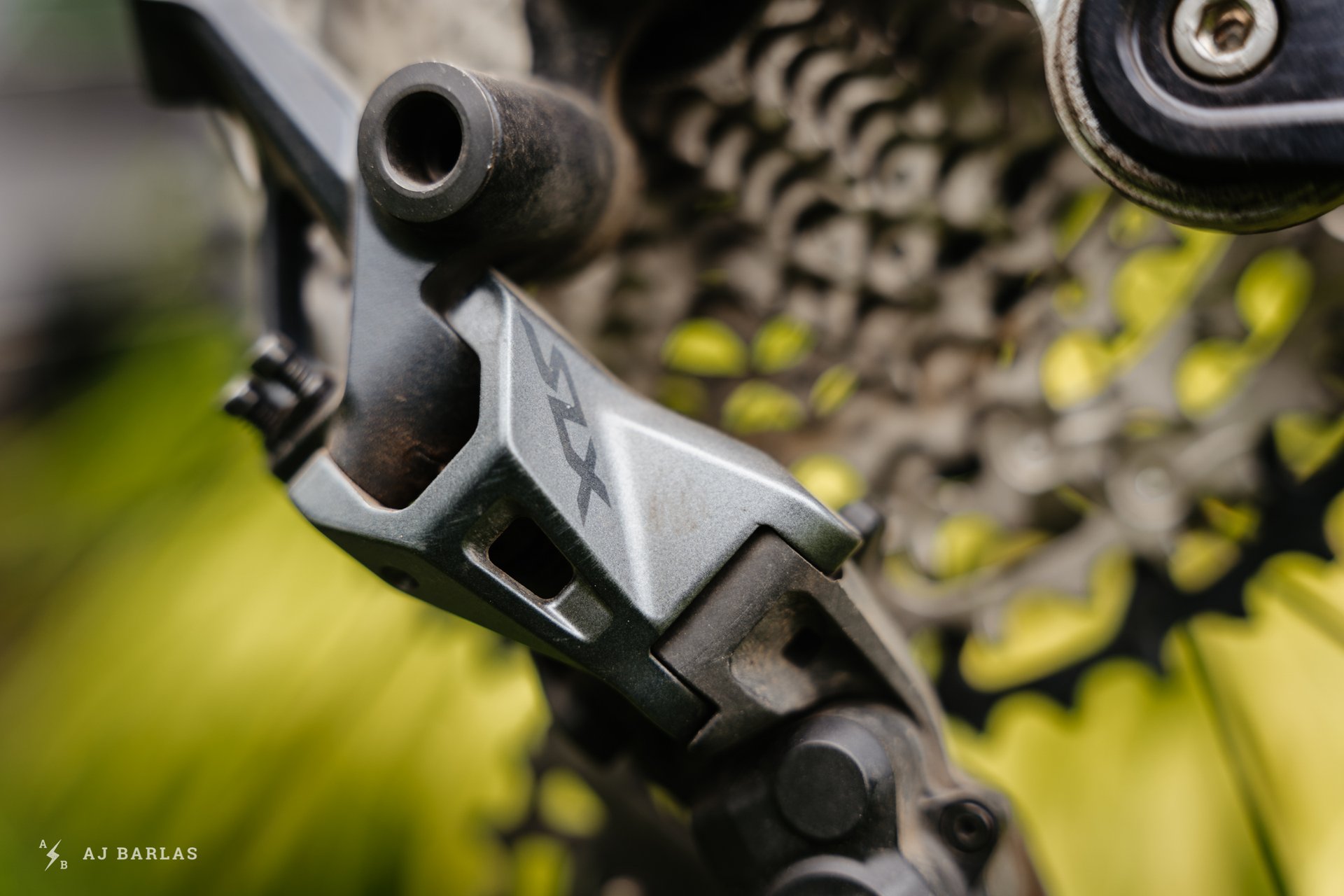
The rear mech looks a little different to the XT (and XTR) but they perform so similarly I couldn't tell the difference.
Compared to the GX drivetrain the SLX replaced, the cassette carries the largest weight difference; 529g vs 450g for the GX. But as mentioned earlier, I also found the ride quality to differ significantly between the two. The SLX shifts are more precise than GX thanks to their new Hyperglide+ technology, which sees the inclusion of shift ramps that impact both up and downshifts. This also feels like something that will work better with eMTB’s thanks to the cassette’s ability to better manage shifts under load. On the topic of eMTB’s, the Shimano Microspline driver and cassette are optimized to work with the torque of an eMTB. (an earlier version of this article suggested that SRAM's XD driver standard and Eagle cassettes are not recommended for eMTB but this was not accurate - although SRAM recommends using their single shift shifter for eMTB).
I’ve ridden the SLX drivetrain with the supplied CN-M7100 chain for the duration of the review and it’s just getting to the 1/16th mark. I’ll be replacing this as soon as I can and will try a higher level option – XT or possibly even XTR – to see if that affects anything. The SLX chain retains the lengthened inner plates that make Hyperglide+ possible but Shimano claims the coatings aren’t as durable. If I get drastically more than 700km out of the next chain, I’ll be sure to write something about it.
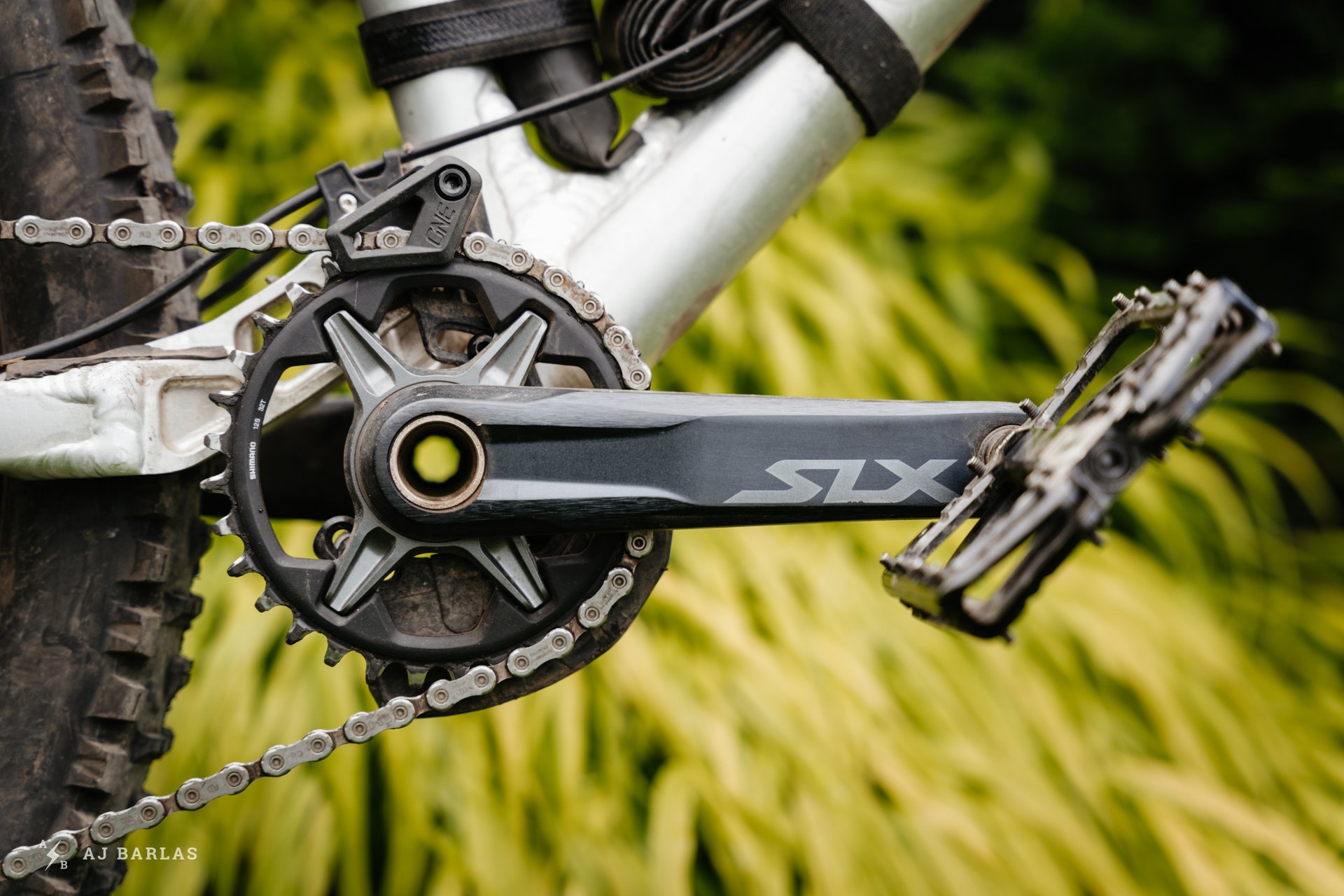
The cranks have been solid. I have nothing bad to say about them.
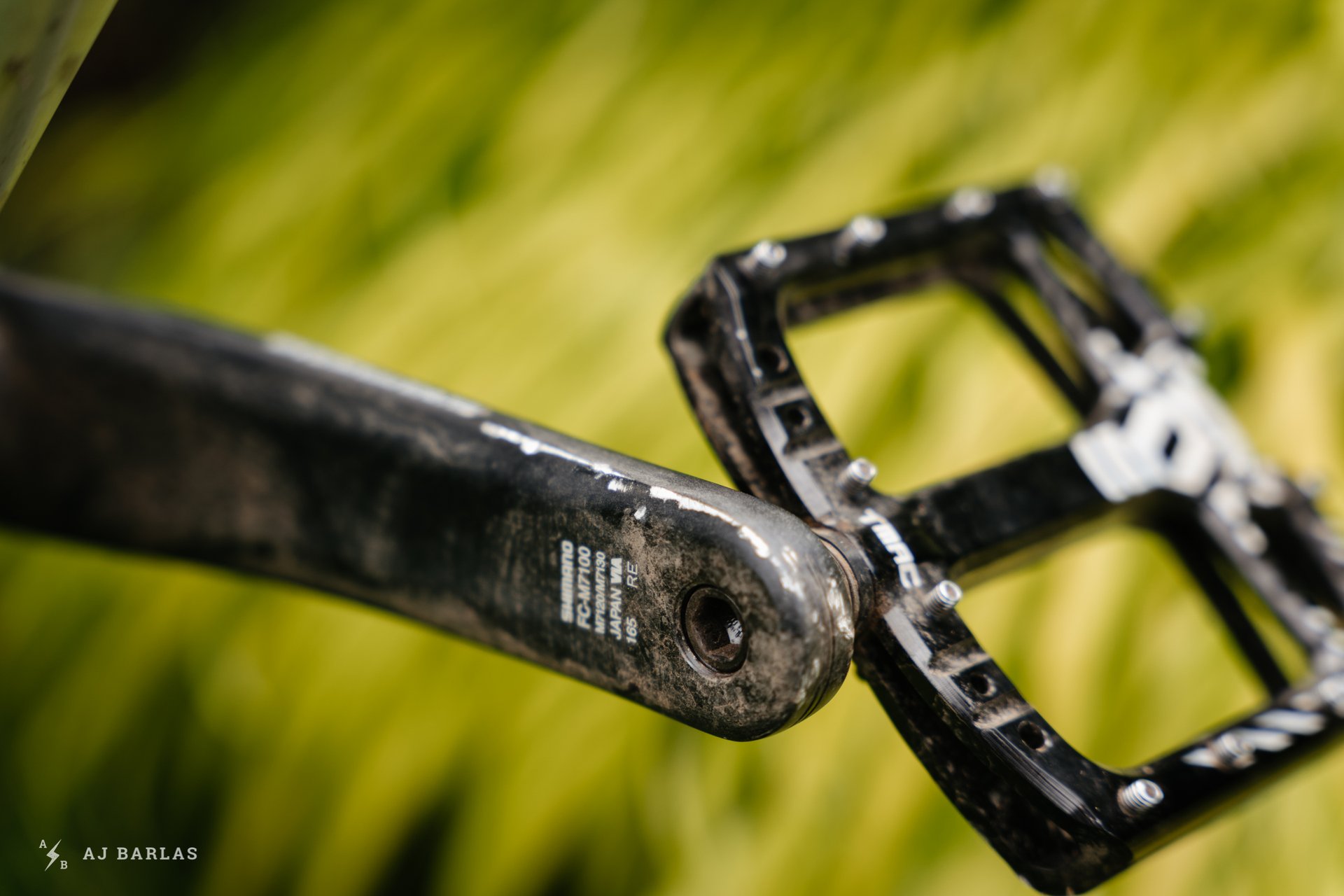
I run tape on the external face of the arms to prevent my shoes wearing them away but anywhere else shows the abuse they've been dished. I expect this of my cranks and it's why lean to metal here.
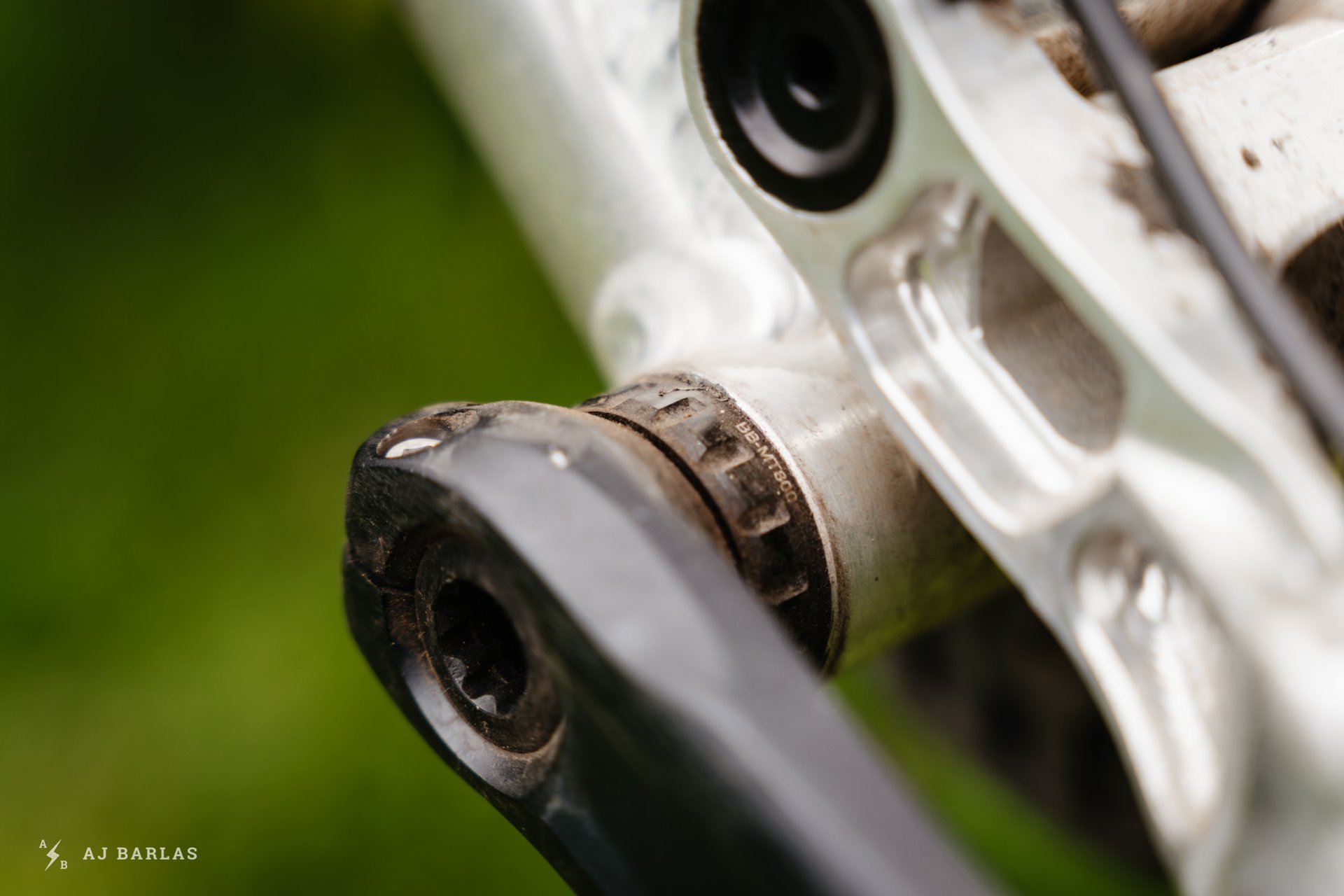
The simple BB/spindle/crank interface is dead easy to work with and hasn't been touched since going on more than six months ago.
Finally, the cranks and bottom bracket have been bombproof throughout testing. Until preparing for this review, I hadn't touched them at all and haven’t heard or felt anything to be concerned about. The cranks are visibly beaten, which I expect for this part of my bikes –a large part of why I opt for metal cranks. Aside from looking used, they’ve gone unnoticed, which is perfect and thanks to the steel teeth on the chainring, I don’t expect a need to change that anytime soon. Setup is dead simple, removal for maintenance equally basic, and they haven’t needed any attention after hundreds of kilometres of abuse. Win, win.
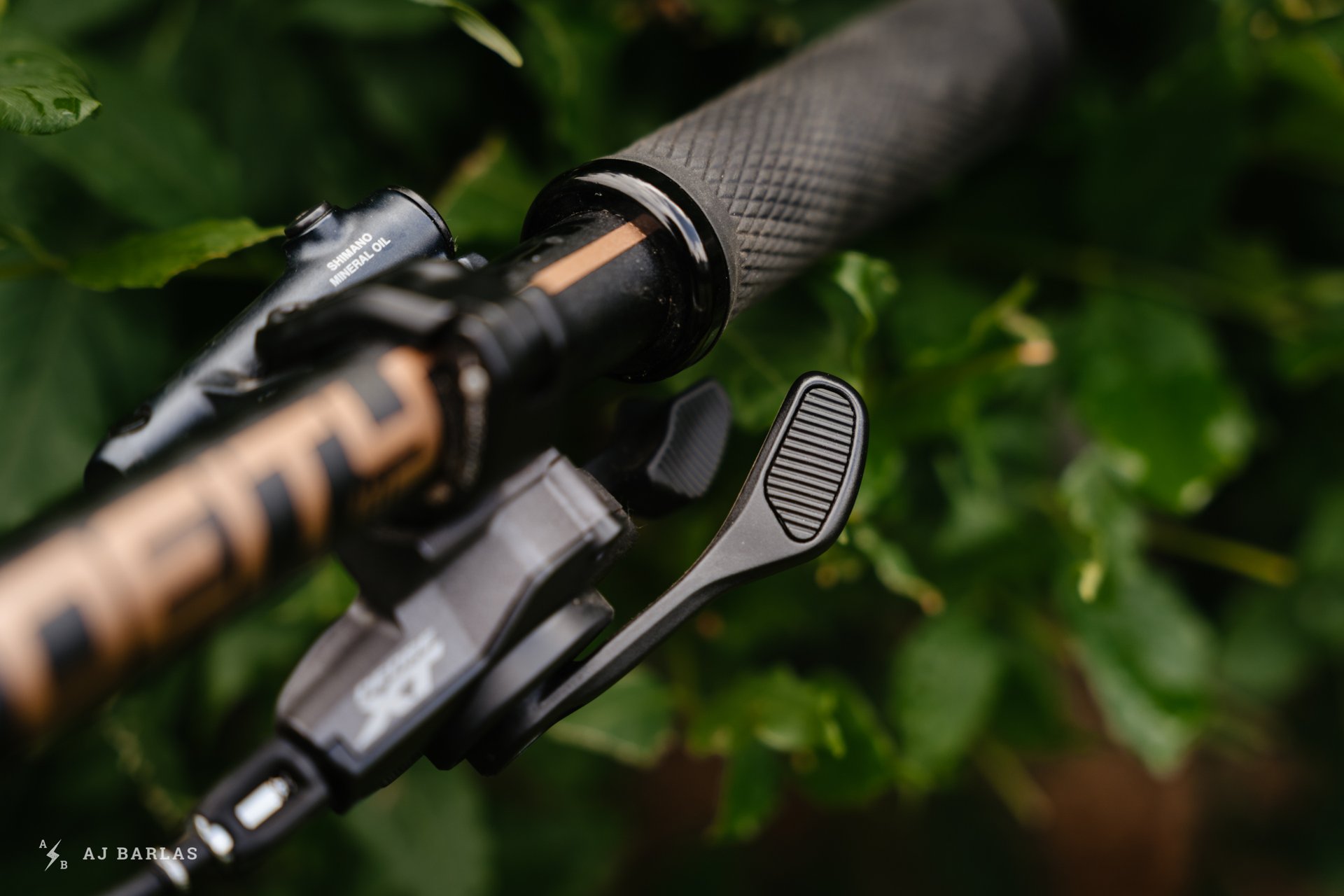
For the money, the XT shifter is the only improvement I would recommend to anyone interested in the SLX drivetrain.
Can It Be Improved?
It’s hard to argue there’s anything wrong with SLX when considering value. That is with the caveat that I believe upgrading to the XT shifter is a must for any discerning or core rider. Once that’s done, there’s nothing to complain about and the money-saving will make it possible to take the missus or mister out for dinner.

The SLX drivetrain has been an eye-opener. Next up, the SLX brakes. Look for that review soon.
Verdict
Testing the SLX drivetrain back to back with GX was an interesting process. Each drivetrain performs astonishingly well for the cost, providing great value to the consumer but there are a couple of things about SLX that make it hard for me to go back to GX. The shifting performance of SLX makes it feel like a much more expensive drivetrain and I find the gearing more comfortable. With the upgrade to an XT shifter, feel at the lever is better and I now have the ability to shift to two higher gears in one hit, something I find myself doing 95% of the time. Even with the shifter upgrade, the SLX drivetrain offers greater value. But if the weight were more important, then GX is the way to go, albeit only for 109 grams – 112 grams with the XT shifter upgrade.
Shimano 12-speed SLX provides ridiculously good shifting and performance for the money, making it hard to argue with. Toss an extra few coins in and you get all of the tech from the higher-priced Shimano siblings in a more wallet-friendly package. I don’t see any need to dig deeper into my pockets with the performance SLX provides and can only imagine it being a status move, a case of weight weenie-ism, or senseless spending to do so; it really is that good.
More information on Shimano 12-Speed SLX can be found on their website.
Age: 39
Height: 191cm/6’3"
Weight: 73kg/160lbs
Ape Index: 1.037
Inseam: 32”
Trail on Repeat: Changes as often as my mood.
Current Regular: Every test product spends time on Entrail










Comments
Poz
3 years, 7 months ago
I’ve always up spec’d shifters, it’s the most physically noticeable element of the drivetrain and makes a big difference.
This review has really convinced me I need to keep an open mind to SLX for my upcoming build. Full SLX drivetrain with the XT shifters could be a good min-max project.
Looking forward to your SLX brakes review. Currently on an old generation of the SLX and they’ve been great (other than the odd pre lever pump I need to do at start of ride)
Reply
Endur-Bro
3 years, 7 months ago
Up spec’ing the shifter is such a power move. 👍🏽
Reply
Poz
3 years, 7 months ago
Sure is. The minimal price differential makes it probably one of the highest dollar to performance upgrades you can get.
Reply
Endur-Bro
3 years, 7 months ago
It’s a contact point. One place a rider should invest money in. And it’s the master in the shifting system.
Reply
Sean Chee
3 years, 7 months ago
I'm with you. Given the indexing magic happens at the shifter, the minimal price delta, and the significant performance benefits, it's a no brainer.
All my bikes since the mid 90's have (unintentionally) come with shimano der's and it doesn't take long for them to end up being actuated by a xt or xtr shifter. Even when the mech has been alivio or stx rc.
Reply
Velocipedestrian
3 years, 7 months ago
191cm rider chooses 165mm cranks. Guess that puts to bed the leg length argument.
I'm still rocking the 10spd SLX derailleur / XTR shifter combo, it's unstoppable. (with third party edits - Sunrace & goatlink)
Reply
RG
3 years, 7 months ago
Was thinking the same.
Don't you loose some leverage compared to a 175? Or is this a misconception?
Reply
Geof Harries
3 years, 7 months ago
Shouldn’t crank length choice also be affected by leg length? There’s plenty of taller people with short inseams and long torsos, in which case this would make sense.
Reply
AJ Barlas
3 years, 7 months ago
I believe so. My inseam is about 32-inches, which is the same as shorter friends. Proportionally I have a longer torso.
I’ve also read the odd article in recent years that suggests longer cranks have little to no gain in output. I think one of them was written by Lee McCormack.
Reply
Enurjetik
3 years, 7 months ago
I'm the same height as AJ and made the switch to 165mm SLX cranks about a month ago. I also have a 32 inch inseam, so that may be coloring my experience, but I've found the change to be universally positive. I scoured the internet for people's experiences on switching from 175s to 165s. I was terrified at the thought of losing what little power my legs push out. According to the internet science wizards (always to be trusted!) the percentage difference is so miniscule as to be unnoticeable. What you will notice is that your pedal spinning circles are smaller and faster, but you'll completely forget about this 45 minutes into your first ride. But the glorious feeling of actually pedaling up rooty, rocky climbs? Well, that lives with you forever, my friend.
Reply
Timer
3 years, 7 months ago
It definitely should. I have yet to hear a compelling reason why we should have rider size specific saddles, handlebars, platform pedals, chainstay lengths and backpacks, but everyone should use the same length cranks.
But keep in mind that crank length impacts transmission ratios. Shorter cranks are equivalent to larger chainrings.
Reply
Andy Eunson
3 years, 7 months ago
I’ve read some stuff lately that suggests shorter is better. But that author sells short cranks. As in 150. His theory is that longer cranks cause your hip to be impinged at the top of the stroke. Maybe. Most mountain bikers sit pretty upright anyway so I’m not sure it’s applicable. Many other small studies I’ve read suggest riders are most efficient at the crank length that they normally ride. I can’t find the link right now though. Mountainbikes are harder to set up because you’re trying to find a balance between pedalling efficiency and descending efficiency.
Reply
AJ Barlas
3 years, 7 months ago
Ha! Love it. Yes, I’ve also read something like that and they went on to try and sell their short cranks – perhaps it was the same one (I don’t remember where I read it)? I have read about opening the hip joint too, and did again today in a new to me article on Training Peaks (https://www.trainingpeaks.com/blog/the-benefits-of-reducing-your-crank-length/). As you say, with our more recent geometry, I’m not sure how much it affects us. But I would be interested in reading the article you mention about the best crank being the one you ride. That sounds like someone I’d enjoy reading content from.
Reply
Alex D
3 years, 7 months ago
Short cranks mean more saddle height. With the pedals level out of the saddle, no matter, but for sit-and-spin, you'll be up higher.
Reply
Endur-Bro
3 years, 7 months ago
You also have to look at his test frame, a G1. Recommended crank length on that frame is 165-170 arms.
Pretty much all the heavy hitter trail bikes for 2021 I’ve looked at are spec’ed with 170mm cranks throughout the size range.
Someone with more time and brains than myself can do the calculations of forces upon a lever in an arc between 165/170/175.
Reply
dorkweed
3 years, 7 months ago
Great review. About the only person who thinks GX is on par or better than SLX is SRAM him or herself. And GX pricing at both retail and OE is inline with XT. SRAM has some work to do...
Reply
Mammal
3 years, 7 months ago
Not to mention Deore cost/performance compared to NX or SX (puke). Lots of work to be done...
Reply
Chad K
3 years, 7 months ago
That said, the SX is still a much lower price point than even Deore, so it's not quite an even comparison. (EDIT: it appears I was mistaken and was thinking of the Deore full groupset cost (w/cranks, etc.) So any price difference is negligible).
I'll also just add that I recently refreshed my SRAM drivetrain (X01 shifter/cassette (10-50)/chain, GX Lunar rear der), and I don't know if it was the change to the x01 cassette or the new Lunar der, but the shifting is notably smoother and better overall. I'd like to think the Lunar stuff sram put out actually has some performance gains from the new spring and also rearranged parallelogram.
Reply
Mitch Stockwell
3 years, 7 months ago
I found the X01/XX1 chain to really make or break the eagle drivetrain. Not sure what chain you were running before, but if it was GX or worse, then my guess would be the chain made part of that impact.
Reply
Chad K
3 years, 7 months ago
Mitch, in this case, I've actually always used xo1 chains for a bit longer wear life. So no change there!
Reply
HollyBoni
3 years, 7 months ago
Some SX Eagle parts are actually more expensive than Deore M6100, and the groupsets are about the same price.
Reply
Chad K
3 years, 7 months ago
I see that, now! Edited my prior post for accuracy.
Reply
Lynx .
3 years, 7 months ago
Good review Al and exactly what I figured after my experience with the 10 and 11spd versions. I also really like that multi-release function, something you could hack in the last iteration of the 9spd shifters, but not 10spd, however in the 11spd lineup, I sacrificed it to get MUCH lighter shifting with the SLX over XT, so glad that they've fixed that issue.
Another thing you didn't mention is that while there's a 80g weight penalty on the SLX over GX, you also only pay 1/2 the cost for one, so that coupled with much crisper shifting is an absolute no brainer to me. It's no wonder with the quality of Shimano's lower end parts like Deore that this year OEM has flocked to them for a cheaper cost, but better performance metric.
Reply
Perry Schebel
3 years, 7 months ago
the increased longevity of the steel SLX 45t cog was a good point as well; no brainer, indeed. shimano's current trickle-down performance, value oriented ethos has won me back to the fold again. now curious if the brake foibles have been resolved yet...
Reply
UFO
3 years, 7 months ago
I couldn't get along with the 11sp SLX shifter. Yes the shifts were lighter than 11sp XT/XTR, but the shift feel felt imprecise, cheap, and plasticy -- worse than a 9sp Deore shifter IMO. Sounds like that has been corrected with 12sp.
So I guess the question is what/if there are any real world performance gaps between 12sp Deore and SLX as the feature set is seemingly identical
Reply
ScaredySquirrel
3 years, 7 months ago
I recently replaced by SRAM NX/GX 12sp with an a la carte Shimano 11sp package and went from the worst drivetrain I've ever used to the best. I was running an NX shifter/cassette with a GX derailleur. The chain drop on backpedal drove me bonkers. It's simply not acceptable on a bike that's made to ride up mountains. Plus the shifting was pathetic. This is after many trips to the LBS where I bought the bike.
So now I'm running an 11 speed system with 28T chainring (same GX cranks but replaced a 30T with a 28T) and a SunRace 11-46 cassette (Shimano 11sp cassettes have too big a gap to get into the big gear).
I've got an 11sp SLX derailleur and splurged on an XTR 11sp shifter for all the fancy shifting options.
This new setup is awesome. No chain drop. Crisp shifts. All the range I want (without a big heavy pie plate at the back).
Happy as heck to be back on Shimano - an old trusted friend. I find no negatives to having 11 gears to choose from rather than 12.
One thing that surprised me was that the old GX 12sp derailleur was 29 grams lighter than the SLX 11sp.
But the old NX cassette was a boat anchor compared to the SunRace so the new system is lighter.
Reply
prairiedirt
3 years, 7 months ago
How much of your Eagle complaint is about the overall integration with the bike?
I have pure NX Eagle on one bike and I can back pedal on the 50t forever and not drop the chain. On another bike I have 11 speed SLX mech /XT shifter/Sunrace 11-42 on another. They perform the about the same overall.
Reply
kekoa
3 years, 7 months ago
I dislike the name ‘SLX’. No idea why, maybe it reminds me of their ‘STX’ grouppo from way back. Should have just kept ‘LX’.
Reply
Sean McDermott
3 years, 7 months ago
I started with SLX cassette, derailleur and shifter and migrated the derailluer and shifter to XT when the SLX clutch got sticky. The XT derailleur has noticeably less drag than the SLX and is a worthwhile upgrade IMO. I think the best budget setup would be SLX Cassette and Shifter with the XT Derailleur. I do also much prefer the ratios of the Shimano cassettes vs SRAM.
Reply
Metacomet
3 years, 7 months ago
Do the 12 speed SLX pulley wheels still run on bushings, rather than cartridge bearings? That was always the biggest/only thing separating the SLX from XT derailleurs. I have swapped out the SLX pulley wheels for nicer ones in the past after they crapped out, or when I needed to add another small item to the cart. It does make a noticeable difference especially once the SLX ones are worn out or contaminated.
Reply
JVP
3 years, 7 months ago
I’ll take bushings in the pulleys every day and twice on Sunday. Way more reliable. (GX grumble grumble).
Reply
Metacomet
3 years, 7 months ago
I think SRAM may be a different matter all together, but I haven't had the bearings in XT/XTR/Saint pulleys start feeling crappy or give me any other sort of issue, but the SLX ones always seemed to get contaminated and feel crappy rather quickly in my experience. I’d clean them and grease them and keep them running until eventually replacing them. I haven’t personally ran a SRAM drivetrain since the 90’s so I cant really comment on them other than seeing many broken mechs and lots of friends complaining about persistent issues trailside. Mostly crapped out clutches, messed up pulleys, and being delicate and finicky overall.
Reply
Ace11
3 years, 7 months ago
Great review. Shimano won me over with SLX 11 speed. Too bad the 2 shift jumps didn’t make it over to 12 speed. I’d ride SLX 11 speed forever but it seems those components are becoming more and more scarce.
Reply
Cam McRae
3 years, 7 months ago
Just a correction note here. An earlier version of this article suggested that SRAM's XD driver standard and Eagle cassettes are not recommended for eMTB but this was not accurate - although SRAM recommends using their single shift shifter for eMTB.
Reply
helpimabug
3 years, 7 months ago
I really want to try out some of the Shimano 12 speed stuff.
But the price/performance king for me is still GX 11 speed. I can find xg1150 cassettes for under $100usd, they’re all steel and weigh 394g. The derailleur is 265g. I swap the b-bolt out for the xx1 and drill out the pin so the clutch is adjustable. Then run an eagle dub crankset with nx eagle chain, degreased and dumonde-ed. Oh,, and a grip shift for as many up or downshifts at a time as I want.
Reply
Chris
3 years, 7 months ago
Not debating the better performance of SLX but as you point out, that alloy cog is not ideal for longevity. I choose GX because there’s an all steel cassette option and I get 2x the life with it
Reply
Heinous
3 years, 7 months ago
The GX cassette works fine with Shimano 12s if that's your thing...
Reply
Chris
3 years, 7 months ago
But negates all the Shimano 12s shifting goodness
Reply
Heinous
3 years, 7 months ago
Some of it. You still get better shifting from the derailleur without the laughably shit GX cage materials and main pivot / knuckle and B-tension tab. It stays better for longer too, GX seems to need regular b-tension adjustment.
Reply
Timer
3 years, 7 months ago
Is the 51 tooth alloy ring really that much of an issue? Back in the days of front derailers, lots of cranksets came with 44 tooth rings made from aluminium. I don't remember them being much of an issue in terms of wear.
Reply
Chris
3 years, 7 months ago
I'm old enough to have rocked the triple chainrings. The only time you were ever in the big ring was pavement or some very mellow/shallow fire road. Conversely, I spend probably 90% of the time in the largest cassette cog. Winch and plummet style. I get about 2500 miles on an XO1 before having to replace the largest alloy cog and then another 2500. I get more than 5000 miles on a GX all steel cassette.
Reply
HollyBoni
3 years, 7 months ago
It's not light (cheap tho) but the M6100 cassette is all steel.
Reply
Endur-Bro
3 years, 7 months ago
Is the alloy cog replaceable like X.01 giant cog is?
Also going to strongly consider a SLX 12spd drivetrain with XTR shifter and chain
Reply
AJ Barlas
3 years, 7 months ago
I don’t think the 51t is replaceable. Look at the attachments in the pics with the blue bg, they’re large, sturdy looking pins.
Reply
Endur-Bro
3 years, 7 months ago
I figured as much those don’t appear to be removable. With the price of SLX cassette or SunRace it probably is less than a WTC/OneUp etc
Reply
David Gelinas
2 years, 4 months ago
AJ I want to thank you for your incredibly concise review of the SLX drive train. I am in a little bit of a quandary and you were a whole bunch of help - THANK YOU
I'm on a carbon Salsa Spearfish SLX that gets ridden on trails most Friday mornings for about an hour and a 1/2 and then in the neighborhood with the grandkids a couple days a week. As a kid I raced BMX and my road bike is a steel/carbon Sarotta w/ a Campy grouppo and a Zonda wheel set.
For about a month now I've had a terrible creaking sound that I couldn't pinpoint. It almost sounds like a creaky saddle but you get the same sound in or out of the saddle. All my pivots are tight as well. It's coming from the rear end and the only culprits could be either the cassette and/or chain. You get it on both sides underload, regardless of the gearing.
I'm here in West central Florida and ride exclusively either Alafia River mountain bike trails (which are truly amazing) or Balm Boyette mountain bike trails. Both of which have a lot of sand and a lot of phosphate. After nearly every ride I wash the bike and then dry it off, which is followed by lubing the chain quite liberally with Squirt. You wouldn't think I should have a whole lot of issues after only a year and relatively limited riding when you think about it.
Based on your review I'm probably going to go w/ a new SLX cassette and take your advice on the XT shifter. I'm wondering if I need to rethink my chain lube.
Any feedback from you or the group would be greatly appreciated.
Thank you
Reply
Please log in to leave a comment.